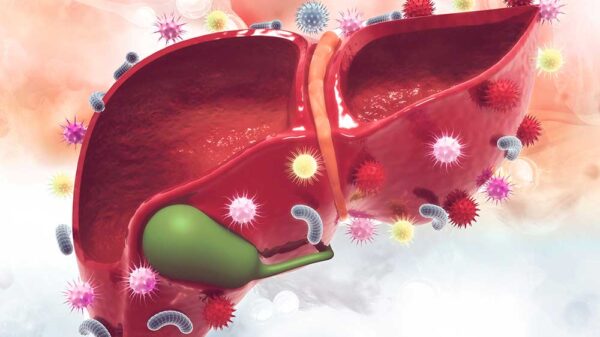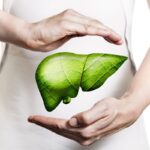Liver size is a good indicator of your liver’s function. A normal liver size indicates that your liver tissue is healthy and is doing its job effectively. On the other hand, an enlarged liver may suggest that your liver isn’t working as it should. Enlargement of the liver is also known as hepatomegaly.
If you’re wondering what liver size indicates about your health, read on. Here we answer your questions about what it means to have an enlarged liver or hepatomegaly.
Clearing Up Confusion Between Hepatomegaly vs. Hepatosplenomegaly
Because they sound similar, hepatomegaly and hepatosplenomegaly are easy to confuse. Before we delve further into what it means to have an enlarged liver, let’s first address the difference between these terms. Hepatomegaly is a term that describes the enlargement of the liver. On the other hand, hepatosplenomegaly describes the enlargement of both the liver and the spleen.
How Liver Size Is Detected
Liver size is detected through several methods. Imaging methods like ultrasound, magnetic resonance imaging (MRI), and computed tomography (CT) scans may reveal abnormalities of the liver. A physician may also detect an enlarged liver through a physical examination using a method called palpation. Palpation during an examination of the liver allows a physician to detect abnormal liver size and liver edge characteristics. A physician will also be able to evaluate the consistency of the liver. For example, a physician can feel if the liver contains soft or hardened tissue.
Imaging tests can reveal liver size as well. For example, ultrasonography can provide a sonographic depiction of the liver. Liver ultrasound technology is also able to show fatty infiltration of the liver. Fat cells more readily echo the sound waves administered by ultrasound machines. Therefore, a high level of echogenicity is correlated with fat accumulation in the liver.
What Is a Normal Liver Size, Anyways?
Science has shown that normal liver span at the midclavicular line for women is about 7 centimeters, and the average liver span for men is 10.5 centimeters. This span may vary from person to person within 2 centimeters of these average values. (1) Keep in mind that liver size may also correlate with body size.
What Does an Enlarged Liver Mean?
The size of the liver indicates how healthy your liver is. An enlarged liver is referred to as hepatomegaly and usually indicates inflammation. Think about when you hit your head on something; what happens? The area becomes red, swollen, inflamed, and tender. The same concept applies to the internal organs, like the liver. When the liver sustains damage, tissues become irritated and inflamed.
An enlarged liver is commonly a result of fatty liver disease. Fatty liver disease is also called hepatic steatosis and describes the accumulation of fat in liver tissue.
Causes of Fatty Liver Disease
Alcoholic fatty liver disease and nonalcoholic fatty liver disease may cause enlargement of the liver. Here we go through the causes of these types of fatty liver disease.
Alcoholic Fatty Liver Disease
Alcoholic fatty liver disease develops as a result of chronic heavy drinking or alcohol abuse. Alcohol is an irritant for the liver. Because the liver is responsible for detoxifying all of the alcohol we consume, it is particularly prone to damage and inflammation in response to alcohol exposure. Alcohol causes the buildup of particles called free radicals in liver cells. Free radicals interact with healthy tissue and induce a state called oxidative stress. Increased levels of oxidative stress cause damage and inflammation that are linked to fatty liver disease.
Nonalcoholic Fatty Liver Disease
Nonalcoholic fatty liver disease is not caused by alcohol abuse. Instead, nonalcoholic liver disease is associated primarily with a diet high in sugar and fat and obesity. Conditions associated with a metabolic syndrome-like type 2 diabetes and insulin resistance are also correlated with fatty liver disease.
Progression of Fatty Liver Disease
Both alcoholic and nonalcoholic fatty liver disease may progress to more severe liver conditions if left untreated. The fatty infiltration of the liver associated with fatty liver disease may advance to a state called steatohepatitis, which describes chronic inflammation of the liver.
Without intervention, steatohepatitis may cause increased liver damage and fibrosis, which is scar tissue production in the liver. Continued fibrosis causes healthy liver tissue to be replaced by hardened scar tissue in a condition called liver cirrhosis. Over time, liver cirrhosis may increase the likelihood of developing liver cancer and liver failure.
Fatty Liver Disease May Be Partially Genetic
Keep in mind that there is often a genetic component to fatty liver disease. Some individuals may be genetically predisposed to developing fatty liver disease, meaning their genetic code affects their metabolic processes and makes them more prone to developing fatty liver disease. Individuals with a family history of fatty liver disease tend to be at a higher risk of developing the condition.
Symptoms of Fatty Liver Disease
You may have no symptoms during the early stages of fatty liver disease. Over time, as the condition becomes more severe, you may experience symptoms such as lack of appetite, nausea, fatigue, and bruising easily. When fatty liver disease progresses to later stages of fibrosis and cirrhosis, you may experience symptoms such as ascites, exhaustion, jaundice, and mental symptoms associated with hepatic encephalopathy.
Can You Shrink Your Liver Back to Normal Liver Size?
In many cases, it’s possible to shrink your liver back to its normal size with lifestyle and diet changes. In fact, many individuals preparing for gastric bypass surgery are often put on a “liver-shrinking diet” by their surgeons. Here are a few tips for reducing liver inflammation and encouraging your liver to return to its normal size.
1. Cut Calorie Intake
Cutting down on the amount of food you eat will help your liver return to normal size. Eating excess food means that energy is turning into fat in the body. Fat is also deposited in your liver, where it can cause inflammation.
2. Reduce Sugar Intake
Added sugar is a major culprit implicated in nonalcoholic fatty liver disease. Eating excess sugar causes blood sugar spikes. When the body cannot use all of the sugar we eat, the sugar gets turned into fat, which is deposited throughout the body. Chronic intake of lots of sugar also increases the risk of developing metabolic syndrome conditions like type 2 diabetes and insulin resistance.
3. Stay Away from Refined Grains
Refined grains are processed in a nearly identical manner to added sugar. When we eat refined grains, the carbohydrates are broken down immediately into glucose molecules and absorbed into the bloodstream. Blood sugar levels spike and excess sugar is converted into fat for storage throughout the body. To lower your intake of refined grains, cut back on your consumption of white rice, white bread, white pasta, crackers, chips, and pastries.
4. Steer Clear of Alcohol
Cutting alcohol out of your lifestyle is a critical move, especially if you have alcoholic fatty liver disease. When you stop drinking, your liver has the opportunity to repair itself. The body and immune system will be able to reduce inflammation and clear oxidative stress. When inflammation and oxidative stress levels are lower, the immune system can more readily intervene and help the body repair.
5. Eat Plenty of Fruits and Veggies
Fresh fruits and vegetables have a therapeutic effect on many conditions, including liver diseases. Fruits and veggies are chock-full of healthy micronutrients like antioxidants, vitamins, and minerals that facilitate lower levels of inflammation and oxidative stress. Eat plenty of foods like spinach, broccoli, sweet potatoes, beets, and berries to support a healthy liver.
6. Use Spices When Cooking
Spices that we use for cooking may help support liver health. Turmeric is known for its anti-inflammatory properties and may help protect the liver from oxidative stress and inflammation. Incorporate turmeric into hearty soup recipes and curry dishes. Turmeric can also be sprinkled into smoothies and used to season popcorn.
Other flavorful cooking ingredients like garlic may also be helpful in reducing inflammation associated with fatty liver disease.
7. Eat Oily Fish
Oily fish like salmon, mackerel, and sardines are excellent sources of omega-3 fatty acids, which fight against liver inflammation. The omega-3 fatty acids found in fish are called eicosapentaenoic acid (EPA) and docosahexaenoic acid (DHA) and protect cells against inflammation. To incorporate even more omega-3’s into your diet, try taking a high-quality supplement.
If you’re a vegetarian, you can still get omega-3 fatty acids from other sources. Nuts and seeds like flaxseeds, chia seeds, walnuts, and pecans contain the plant form of omega-3 fatty acids called alpha-linolenic acid (ALA).
8. Consume High-Quality Protein
A high-protein diet is often recommended when you are aiming to reduce inflammation and enlargement associated with fatty liver disease. High-quality protein is crucial for lowering inflammation throughout the body. Low-fat yogurt, cheese, and chicken breast are great examples of high-quality proteins that offer optimal ratios of essential amino acids. The body can use essential amino acids to build muscle tissue and support nearly all cellular processes.
9. Drink Plenty of Water
Staying hydrated is an important part of reducing inflammation in your liver. Drinking lots of water can help flush out toxins and waste products. Keeping your water intake high can also keep your circulation up, allowing nutrients and oxygen to reach your liver more easily. Nutrients and oxygen are indispensable resources as your body works to repair liver tissue and reduce inflammation.
Other Causes of an Enlarged Liver
Fatty liver disease isn’t the only cause of an enlarged liver. Other diseases and conditions can lead to enlargement of the liver.
Amyloidosis
Amyloidosis is a condition that may lead to hepatomegaly. Amyloidosis occurs when a protein called amyloid accumulates in tissues throughout the body. Amyloid accumulates because of dysfunctional cellular processes due to genetic factors, inflammation, or an autoimmune condition. Excess amyloid in the liver causes liver inflammation and enlargement. Amyloidosis may also affect other organs throughout the body, such as the heart and the brain, and may cause heart failure or liver failure if left untreated.
Gallstones
Liver enlargement may also occur as a result of a blockage in the biliary ducts. The biliary ducts, also called bile ducts, serve as a connection between the liver, gallbladder, and small intestine. These ducts are responsible for carrying digestive fluids to the small intestine to aid in the breakdown of fat particles. However, bile ducts can become clogged or blocked by gallbladder issues like gallstones, causing a backup of fluid in the liver, leading to liver enlargement.
Gaucher’s Disease
Gaucher’s disease is another cause of an enlarged liver. Gaucher’s disease is a genetic condition that results in the buildup of a particular kind of fat in the body, called. This condition is classified as a lysosomal storage disease, which means that the lysosomes are unable to metabolize certain carbohydrates or fats effectively. Normally, the lysosomes are organelles within a cell that contain enzymes that break down macronutrients.
In the case of Gaucher’s disease, lysosomes lack an enzyme called glucocerebrosidase, which is responsible for breaking down glucosylceramide. When these fat particles deposit in different organs, they can inhibit normal organ functions. An accumulation of glucosylceramide can also cause liver enlargement.
Hepatitis
Hepatitis A, hepatitis B, or hepatitis C may cause liver inflammation and liver enlargement. These three types of hepatitis are viral infections that specifically target the liver. Hepatitis A and hepatitis B are generally preventable by vaccine. Hepatitis C is more common in the United States than hepatitis A and B, and it is transmitted through sexual contact or contact with contaminated blood.
Liver Cancer
Liver cancer, or hepatocellular carcinoma, is a more rare cause of hepatomegaly. If there is a cancerous growth in your liver, you may also be diagnosed with hepatomegaly. The malignancy may physically cause your liver to be asymmetrically enlarged. Other types of cancer that are not specific to the liver, such as leukemia and Non-Hodgkin lymphoma, may also cause an enlarged liver.
Diagnosing and Treating an Enlarged Liver
When you are diagnosed with an enlarged liver, it is important to determine the root cause of liver inflammation. You may interact with health care professionals in internal medicine, hepatology, radiology, and gastroenterology. There is overlap among the different specialties for treating an enlarged liver.
For example, if your enlarged liver is connected to dysfunction in the gastrointestinal system, you will benefit from seeing a specialist in gastroenterology. If your case of hepatomegaly stems primarily from fatty liver disease, you will most likely be treated by a hepatologist. If you have an enlarged liver as a result of liver cancer, you will also need to see an oncologist for treatment.
Conclusion: Normal Liver Size vs. Enlarged Liver
A normal liver size is a good indication that your liver is healthy and functioning as it should. On the other hand, an enlarged liver usually signifies that something is wrong. Hepatomegaly is often caused by either alcoholic or nonalcoholic fatty liver disease. Luckily, there are steps you can take to reverse fatty liver disease and help your liver return to its normal size. Other, less common causes of liver enlargement include liver cancer, hepatitis, Gaucher’s disease, and amyloidosis.

References:





















